The switch from manual to digital
That well known saying ‘Look after the pennies and the pounds will look after themselves’ might fall on deaf ears in a busy, overstretched accounting department. It’s hard for any business to change over from a manual to a digital system, especially in the finance department as vital work is carried out on an ongoing daily basis and the disruption is perceived as substantial. According to a report by the Institute of Finance and Management (2015) 66% of invoices are still paper based. The same report suggests it costs nearly £10 to produce just one invoice and over 60% of this is in staff costs. Put another way, by switching to a paperless invoicing system, over 60% of firms get the cost of conversion covered within 12 months and of course these savings and benefits are ongoing, with digital invoices typically costing half the paper one. “There are clear economic returns, process efficiencies and improvements to supplier management that are all too attractive to ignore.” AP Association website
The inaccuracy of manual invoices
Aside from paper invoices being expensive and time-consuming, there is an inaccuracy issue. With the best will in the world, accounts people make mistakes, more so if they are rushed, feeling a bit under par or maybe are not just up to the job. With computers, one doesn’t have these human failings, so a digital invoicing system will give you accurate information and reduce the need to get invoices redone, which costs both time and money and your customers’ frustration.
We are too busy to switch
Most people accept converting is the sensible thing to do but many stumble over when is the best time to do it. Of course, there is never an ideal time but this is something that would be part of the discussion with your prospective outsourcing partner. It makes sense to choose your conversion company carefully and one that can offer a bespoke system; cookie cutter solutions rarely work seamlessly. Pets Corner – the ethical national pet store – completely outsourced their purchase invoices, with staff only needing to do any manual inputting if mistakes were detected. Despite store numbers nearly doubling during the transition period to 180 and invoices increasing from 2,000 per month to 5,000, no extra staff were needed in the finance department. Financial Director Ian Dougall was highly satisfied with their newly automated invoice processing, “Staff now have time to focus on core tasks within the business.”
And they’ve saved a few pennies, too.


